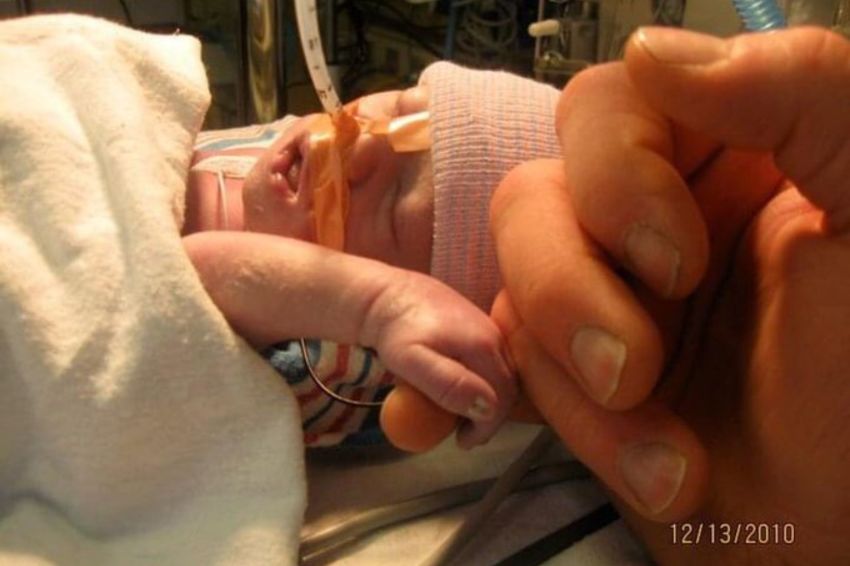Mother reveals why she refused abortion after baby's terminal diagnosis: 'It's not my right to take someone else's life'

What does it feel like to consistently be asked by doctors if you want to abort your baby?
"Incompatible with life': Those were the words echoed to one mother who, despite the numerous voices against her, chose the gift of life for the baby girl she loved immensely and whose life was heartbreakingly short.
Sarah St. Onge, whose name has been changed to protect her identity, was nine weeks pregnant with her daughter, Beatrix, when doctors first began to detect problems with her pregnancy. St. Onge and her husband, John, have a blended family and reside in New York state, each having brought two children into the marriage for a family of six before she became pregnant with Beatrix in 2010.
Prior to Beatrix coming into their lives, St. Onge said she would have considered herself to be pro-life, but with exceptions for cases in which a child wouldn’t survive after birth. But her perspective completely changed after deciding to carry Beatrix to term despite being told her baby would never be healthy enough to leave the hospital.
At one point during an ultrasound appointment, a doctor warned St. Onge that she would likely miscarry.
Although she never miscarried, 12 weeks into the pregnancy, her doctor found a large amount of fluid on Beatrix’s nuchal fold — the fold of skin at the back of a baby's neck. It appeared that the baby had some sort of genetic defect, which St. Onge and her husband thought might be Down syndrome.
After the 12-week appointment, St. Onge and her husband discussed what raising a child with Down syndrome would be like. The pair knew they wanted to carry their baby to term regardless of whether their child had that or any other condition.
By the 16-week appointment, however, a cystic hygroma (an abnormal growth that can appear on a baby’s neck or head) had formed along with a large omphalocele (meaning the abdominal wall failed to close and her organs protruded into the base of the umbilical cord). This appointment was the first time the couple had ever heard the term “incompatible with life.”
During an appointment to get an amniocentesis that same day, Beatrix was tentatively diagnosed with Trisomy 13, a chromosomal defect that is sometimes fatal and can cause physical and intellectual disabilities.
In response to St. Onge’s questions about treatment options, the genetic counselor advised abortion, telling the expectant mother that she would never be able to take her baby home. Even if Beatrix somehow survived, the genetic specialist asserted that the child would end up living in an institution.
While the mother was stunned by the doctor's prognosis and advice, she was determined to carry her daughter to term.
“We don’t determine somebody's ability to overcome something before they’re even born,” St. Onge told The Christian Post. “There’s only so much that testing can do. But the bottom line is that it’s not my right to take someone else’s life. Nobody has the right to decide if somebody else should live or die.”
Starting from her 16-week appointment and going into 24 weeks, St. Onge recalled that doctors offered her the option to abort the pregnancy at almost every appointment. Despite requesting that they write something in her chart saying that she did not want an abortion, the doctors told St. Onge that they had to give her the option, as it was a consent issue.
When the results from her amniocentesis eventually came back, it revealed that Beatrix did not have any genetic defects as doctors had suspected. For a short time, St. Onge began to have hope.
But then, during her 26-week appointment, she learned that Beatrix had a condition known as Limb Body Wall Complex, an abnormality where the baby’s organs are on the outside of the body.
On Dec. 12, 2010, St. Onge went into labor at a hospital in New York that, at the time, did not have a perinatal hospice program. The mother said she asked the doctors to provide a steroid injection to boost her daughter’s lung development, but her request was denied. Doctors informed her they wouldn't provide that level of care for babies who are expected to die.
Despite enduring all the “chaos” that led up to her daughter’s birth, St. Onge described the experience of holding Beatrix in her arms as “very peaceful.”
“It almost felt like there was nobody else in the world, just my husband, me and her, sitting in that room in the quiet,” the mother recalled. “She was beautiful and lovely, and it was good. It was all good.”
St. Onge and her husband used the precious time they had with their baby girl to hold her and commemorate her short life. Beatrix lived for 1 hour and 47 minutes. St. Onge said she’d go through the pregnancy and labor a second time just to have that amount of time with Beatrix again.
Elaborating on why she chose to carry her daughter to term instead of opting to have an abortion, St. Onge asserted that “a baby is not an object,” and said that continuing her pregnancy was not an “accomplishment.”
“Babies are not possessions,” she said. “They’re individual human beings. And part of being human is that we die. And the love that you invest in people before that point outweighs any pain and suffering that you feel when they leave.”
She also noted that when pro-choicers advocate for abortion in fetal anomaly cases, they usually emphasize that the preborn will suffer if the pregnancy continues. But when defending certain abortion procedures, particularly late-term abortions, the same people are usually quick to defend the practice by claiming the unborn do not suffer.
“If you’re worried about [children like Beatrix] suffering, then why aren’t you worried about the suffering of the thousands and thousands of children whose lives are ended in legalized abortion?” she asked.
In addition, St. Onge noted that Beatrix was delivered via C-section, and she did not suffer during the delivery.
Within five days of Beatrix’s passing, St. Onge’s husband met with a funeral director while she recovered in the hospital. During the meeting, the funeral director asked St. Onge’s husband, "And you never thought of terminating the pregnancy?"
At that point, St. Onge said she believed her husband became upset and almost left before the director explained that his wife had also carried their daughter to term after an adverse prenatal diagnosis.
The funeral director turned out to be “helpful,” as the hospital where his wife had delivered had a perinatal hospice program and understood what parents needed most. Whereas, the hospital where St. Onge delivered did not have such a program where the staff was trained on what to do for grieving parents.
“He (the funeral director) is the only reason that we have — and this is heartbreaking in and of itself for my husband when I think about it — but he and my husband are the ones that did the casts for her handprints,” St. Onge said.
The hospital had provided the parents with birthing paperwork that contained Beatrix’s hand and feet prints and a cast of her foot. But the release forms incorrectly stated that St. Onge’s pregnancy had ended in a miscarriage.
“They threw out all of the bedding that she had been in,” the mother recalled. “I had to tell a nurse, and the nurse had to go dig in the garbage to get the blanket that she had been wrapped in. Nothing was saved for us.”
St. Onge expressed sympathy for the nurses attempting to care for patients like her at a hospital without a perinatal hospice program, recognizing that a lack of proper training likely had to do with the treatment that she and her husband received.
“If there's not a perinatal hospice program involved in the hospital, then that means that the medical professionals that are dealing with people who are choosing not to terminate a pregnancy are also suffering,” she said. “Because I can't imagine being a nurse and having no context for this.”
Following Beatrix’s death, St. Onge recalled that the first few years were the hardest, with the second year being the most difficult as, by that time, she said most people expect you to have overcome your grief.
“People are afraid to talk about it. But the reality is that someone is missing in our household,” she said. “And as a mother, the loss of an aunt, uncle, or a cousin is not felt as keenly on an everyday basis because, in this case, there’s a child missing from my house always.”
“Over the years, it has lessened as far as grief,” St. Onge added. “You know, as they say, ‘sometimes it’s very slow and shallow, and sometimes it’s big roaring waves crashing on a shore.'"
In 2011, St. Onge started a website called Limb Body Wall Complex.net to help other pregnant women whose children received a similar diagnosis by providing them with information about the condition and stories of women who carried to term. While she said that she had stepped away from the website over the years, she is in the process of rebuilding it.
Samantha Kamman is a reporter for The Christian Post. She can be reached at: samantha.kamman@christianpost.com. Follower her on Twitter: @Samantha_Kamman



























